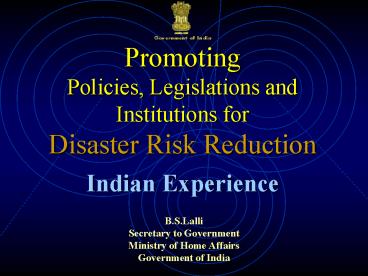Promoting Policies, Legislations and Institutions for Disaster Risk Reduction - PowerPoint PPT Presentation
1 / 10
Title:
Promoting Policies, Legislations and Institutions for Disaster Risk Reduction
Description:
Political Economy. Development. Environment. Disaster Risk Assessment ,Reduction and Management ... Ensuring political commitment at highest level ... – PowerPoint PPT presentation
Number of Views:37
Avg rating:3.0/5.0
Title: Promoting Policies, Legislations and Institutions for Disaster Risk Reduction
1
Promoting Policies, Legislations and
Institutions for Disaster Risk Reduction
Indian Experience
- B.S.Lalli
- Secretary to Government
- Ministry of Home Affairs
- Government of India
2
Evolution of Public policy on disaster reduction
- 1960s Comprehensive food security prevented
famine which was recurrent phenomenon prior to
Independence. - 1980s Integrated poverty reduction strategies
reduced adverse impact of natural disasters - Various disaster mitigation programmes such as
DPAP, DDP, EGS, Watershed Management, crop
insurance. - Micro credit through self groups mostly of women
enhanced resilience of communities - Devolution of powers to rural and urban self
governing institutions empowered local
communities
3
Turning point growing Disaster Losses
- During IDNDR India lost 2.2 of its GDP annually
(US6 billion) due to disasters - This highlighted need to have a comprehensive
policy on disaster risk reduction and management
Reported Catastrophe Losses in India, 1965-2001
US Millions
4
Paradigm shift From disaster Response towards
Disaster Reduction
- Government appointed HPC on Disaster Management
(1999) which submitted one of the most
comprehensive reports ever produced. - Tenth Five Year Plan (2002-07) outlined a
multi-pronged strategy for total risk management
for sustainable development - The WCDR organized by the International Strategy
for Disaster Reduction was opportunity for
Development of Disaster Management Framework that
India presented in January 2005 - India actively participated in drafting the Hyogo
Framework for Action building Resilience of
Nations and Communities to Disasters
5
National Disaster Management Framework
Political Economy
Development
Environment
Disaster Risk Assessment ,Reduction and Management
Prevention, Preparedness
Response, Recovery
Early Warning
Shelter
Non-structural measures Poverty
alleviation Empowerment of women Capacity
Building Risk transfer, insurance
Structural measures Infrastructure Environmental
shield Retrofitting
Intermediary
Search and rescue
Relief
Permanent
Sustainable Development
6
Disaster Management Act 2005
National Disaster Management Authority Chairman
PM
Central Government
National Executive Committee
MHA
State Government
State Disaster Management Authority Chairman CM
NIDM
NDRF
State Executive Committee
District Administration
DMD
District Disaster Management Authority Co-Chairmen
DM/Chairman ZP
Panchayatss
Municipalities
7
Implementing HFA
- Policy legal-institutional framework furthering
HFA Agendas in following ways - Ensuring political commitment at highest level
- Mainstreaming disaster risk reduction in
development - Providing resources for mitigation, Response and
Recovery - Applying ICT and ST for disaster risk reduction
- Implementing largest CBDRM programme in world
- Mainstreaming DRR in education system , through
school curriculum - Raising NDRF as specialized force for response
- Developing NIDM as apex body for capacity
building
8
Promoting Global and Regional Cooperation in
disaster Reduction
- India worked closely with International Strategy
for Disaster Reduction in developing the Asian
Strategy for Disaster Reduction at the Beijing
Conference - India took proactive role in developing SAARC
Regional Framework for Disaster Risk Reduction in
South Asia - India plans to host the next Ministers- level
Conference to review the implementation of the
Asian Strategy for of Disaster Reduction India is
maintaining WMO regional early warning network - India is hosting SAARC Disaster Management Centre
at New Delhi
9
Challenges ahead
- Recent disasters like Tsunami and Mumbai floods
have demonstrated that much needs to be done - Growing economy and urbanization have exposed
more areas, assets and people to risks - Enforcement of building codes and zonal
regulations in rural and urban areas still a huge
task - Communicating early warning to the last mile
- Diversifying livelihood opportunities in disaster
prone areas - Promoting effective regional cooperation under
HFA
10
Thank you































